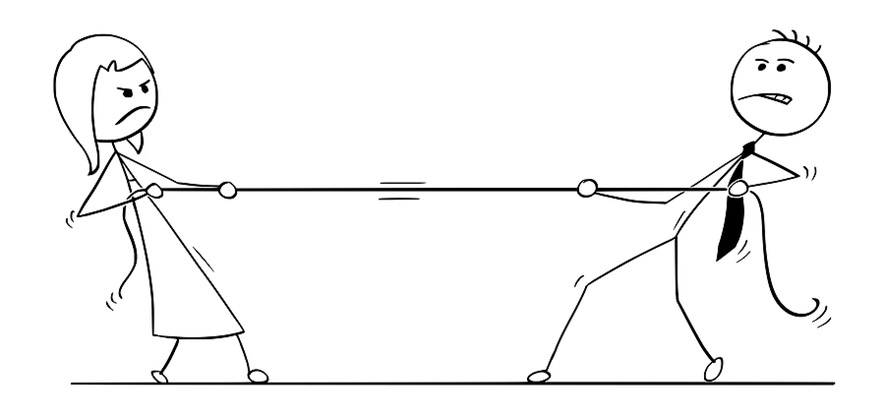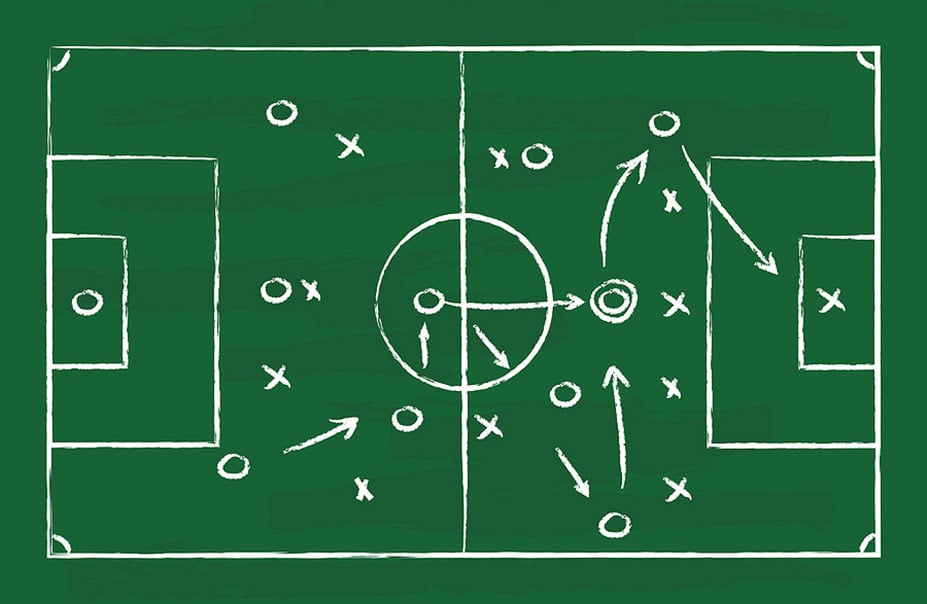Written by Sean McPheat | 

During the sales process most people will raise objections. Sales objections are raised for many reasons including:
When people are about to make a buying decision they worry. What they worry about is making a mistake. This is the most common time, in the sales process, when objections are raised; just before the decision to purchase.
Often, what the customer is looking for is reassurance that their decision to buy is the right one. Therefore, objections are commonly raised at this stage.

The problem with objection handling is that if we observe the behaviour of salespeople during this process, it can be quite negative.
The most common thing that happens when a salesperson hears an objection is that they interrupt the customer.
The customer says, “It looks a bit expensive” and the salesperson, who has heard the objection many times before, interrupts and jumps into the conversation.
What often then happens is the salesperson effectively says to the customer “We are not too expensive” and then offers evidence to prove the statement.
Psychologically, what has happened is the salesperson has said, in effect, “You are wrong, and I can prove it”
I don’t know about you, but I don’t like:
1. Being interrupted
2. Being told I am wrong
3. Being proved I am wrong
Most salespeople when faced with an objection tend to react too quickly and don’t ask enough questions. This is a bad tactic since none of us like to be wrong and all of us hate to be proved wrong. This method, therefore, of responding to an objection with a statement of fact is unwise since it puts the customer in the wrong frame of mind.
Rather than attacking our customer’s beliefs or opinions we should try to get them on our side. The golden rule should be that whatever the objection, you should never openly contradict a customer.
It may be that the customer has misunderstood something you have said previously or maybe feels it is his or her duty to question some of your claims about your product or service to test their validity. Whatever the objection and whatever the circumstances the least powerful way to handle a sales objection is with a statement of fact.
There is a simple objection handling technique that can be used to answer any sales objection.
1. Listen to the objection.
2. Clarify the objection.
3. Deal with the objection.
4. Advance the sale.

1. Listen to the objection
Resist the temptation of interrupting the customer. You may have heard the objection a hundred times before but not from this customer. It may also be that the customer has more than one objection, or that this objection is slightly different than the ones you usually hear.
By listening you show the customer you are interested in their problems and enhance your own professionalism. It also gives you time to think of a way of answering the objection. We’ve got a great article on how you can improve your listening skills that will help with this.
2. Clarify the objection
It is very easy in the heat of the moment to mishear what your customer has said and begin to answer the wrong objection.
So, for example, when the customer says you are too expensive it can mean different things.
The customer could mean:
It could also be that when you test your understanding of the objection you find that your customer has another objection that is trivial and can be handled with ease.
To clarify the objection, you could say something like:
“When you say we are a little expensive, can you be more specific?”
We then need to probe and find out the real reasons behind the objection, before moving to the next stage. It could be that by the end of this stage of the process you identify, for example, they have had a slightly cheaper quote from a competitor.
Once you have enough information it is now time to deal with the objection.
3. Deal with the objection
Once you fully understand the nature of the objection then it can be answered in different ways depending on whether it is:
Misunderstanding
Where the objection is based on a misunderstanding of something you have said then you must:
For example, the customer says:
“I don’t wish to see anyone from your company as I am working full-time and can’t afford to take time off work during the day.”
The customer has clearly misunderstood the fact that someone will be available to call outside normal office hours.
“I’m sorry, Jane. I haven’t made myself clear. I will be pleased to call at any time in the evening to suit yourself. Would 7.30 on Thursday be convenient or would you prefer a slightly earlier time?”
Disbelief/Value
This occurs where you have made a statement and the customer does not believe you, or at least doubts some of the claims you have made. With this you have not built sufficient value in what you’re selling.
For example:
“I think you’re too expensive”
To answer this and other types of objections there is a method called Feel, Felt, Found, which is very effective for dealing with objections without attacking your customer’s belief system.
Let’s use the price example.
After clarifying, we could say:
“I understand how you feel Jane. Other people have felt the same. People in the same business as yourself who are now our customers. When we first made contact there were often other companies who were able to provide quotes that were a little bit cheaper than ours. However, what they found was that because we have invested heavily in new technology and are able to guarantee a 3-hour response to any problems that may occur during implementation, it was very much more cost effective in the longer term to pay a little bit more up front. So, that being the case, would you like to go ahead with the project?”
Product Disadvantage
This occurs where there is a feature of your product or service that is genuinely less advantageous than a feature of a competitor’s product or service. For example, the customer could say:
“We use a local company with an office in the high street.”
There is a disadvantage here because you don’t have a similar office in this location and is a genuine disadvantage, which needs to be put in perspective.
We try to overcome the disadvantage by stating the advantages of dealing with your company, in the hope that the advantages will outweigh any disadvantages.
However, before we deal with the objection, we need to clarify why having a local office is important to the customer and whether other parts of our service might outweigh the disadvantage that has been identified.

Objections occur for many reasons. Maybe you haven’t built up the value of your solution. It could be the buyer has a similar solution and doesn’t want to change. Or they don’t trust that your products are right for them or their business.
Don’t be put off by objections.
With some proper Sales Training on how to overcome them you will welcome them in the future knowing how to handle them effectively so you can progress the sale.
You ask for the order and you’re trying so hard to close the sale but the prospect does not accept. Is the prospect objecting, stalling or is there a condition that is preventing the sale?
I know these terms are familiar, but I don’t believe most salespeople understand the differences between these three no-sale responses.
However, understanding the difference will allow you to respond in the proper manner, and help you close a few more sales.
Before I cover the 10 hardest sales objections to overcome let’s look at whether the objection in the first place an objection, a stall or a condition is indeed.
First, understand that an objection is a situation in where the prospect CAN buy, but has decided not to do so.
While there may seem to be 10,000 objections out there, essentially there are only two.
The prospect, for one reason or another, does not fully believe in, or is not SOLD on, the analysis of the problem, or the solution to solve it.
Diagnosis and Prescription
For the prospect to buy, your product or service must solve a problem the prospect is having or satisfy some desire.
Therefore, you must unearth the prospect’s problems to expose the want and need. You achieve this by asking lots of probing sales questions and digging deep into their situation, needs and wants. You then present the solution to solve those problems and satisfy the want and need.
When the prospect objects, they disagree with your assessment of the problem or your solution to it. Either they do not believe that the problem, the need, is as bad or as urgent as you say, or your solution will not solve the problem, or it cost more than the problem itself.
Objections are a good thing; in that they expose areas in your sales interaction where you may have come up short. Remember, however, that with an objection, the prospect has decided. The decision was “NO.” That is also good, because now you can give the buyer NEW information so that they can make a NEW decision
In our selling skills training we cover stalls which are when the prospect has NOT decided and is doing everything possible NOT to make a decision. The problem salespeople have with a stall, is that they usually try to get the prospect to decide AND make a positive buying decision at the same time. That’s too much to ask for.
Often, the salesperson is trying to overcome an objection when the prospect has not yet decided. In such a case, there IS NO OBJECTION to overcome. The prospect will not decide. With a stall, just help the prospect to decide, either “YES” or “NO.” Then, if the decision is no, you have an objection.
A condition is a situation in where circumstances make it impossible for the prospect to buy. A condition is something that neither you nor the prospect can do anything about. A condition is an obstacle in where even if the prospect desperately wanted to buy, they could not.
All throughout your sales funnel stages you should have qualifying filters in place to eliminate prospects that cannot buy, very early in the sales process. However, you will sometimes end up in a situation where something will prevent the sale.
Far too many salespeople today, accept routine objections and stalls as if they are conditions, when they are not.
“Your displays look great, and I really wish I could buy them. But our home office will not allow us to display merchandise from outside vendors. It is a violation of my franchise contract.”
That is a CONDITION.
“Your displays look great, and I really wish I could buy them. But I really just don’t have the funds right now…”
That is NOT a condition.
So, remember:
An objection = give more information to get a new decision.
A stall = help the prospect decide and be willing to accept “NO.”
A condition (a real one that is) = qualify your prospects better and avoid this.

If you walk away at the first sign of resistance, you will fall at the first hurdle.
Firstly, you need to be aware of why the objection has occurred and then see whether there is a route you can take to work with and convince the prospect they are better off with your solution than without it.
The best way of dealing with objections is to firstly understand their cause.
Really listen to what they are saying.
If they consider you are too expensive, then analyse why you didn’t build up enough value, rather than concentrating on reducing your price.
When you know the rationale, you can then identify the best way forward to deal with it.
But firstly, get to the route cause.
Here are ten of the most common objections and some suggestions of what to do with each one:
“You’re Too Expensive”
This is probably one of the more common responses, as everyone is trying to cut their costs in business.
You will come up against the price objection a lot.
Remember…if you start focusing on price, you risk getting into a transactional discussion, where justification goes into the background and simple positional pricing comes to the fore.
Instead, look at how valuable your solution would be for your client’s business and work on how the savings they would enjoy, or the longevity they would experience, or the ease of use they would observe, would all outweigh any seeming discrepancies with price they may have observed.
“There’s No Budget Left This Year”
With this one, the client may well be telling the truth and literally has no funding to deal with it now.
You can determine if that is the only reason they aren’t going ahead; in which case, build up the value of using you when the time comes to set the budget.
Keep in touch with them during the time it takes to secure budget and then approach them with the solution again.
If they really want the product now, maybe there’s a way you can help them support the application for further budget by highlighting the savings the company would make if they bought now rather than waiting.
The savings or productivity increase may outweigh the need to wait for Budget sign-off. This is where your consultancy skills may help them improve their business opportunities.
“We’re Already Using Competitor X For This Product”
For most salespeople, this is the end of the line, as they take the slow trudge back to their office and, head bowed, tell their manager there’s no chance with this prospect.
Instead, feel happy that the prospect has realised they have a need for a product like yours.
Find out how the relationship is going with their current supplier, and if there is anything they are still looking for that they are nor enjoying with that supplier.
How’s the relationship going?
Is there anything more they could get that they aren’t now?
Questions like these sometimes creates dissonance with the prospect; they start to wonder if everything in the garden really is as rosy as they suppose.
Talk about how your product may be able to improve results in the future for them, so when the time comes to renew or replace, your product is on their list of preferences.
“We Don’t Have A Problem With That Right Now”
Very often, this comes up because they are in a contented position, comfortable with what they have and the results they are getting.
They may not know that your product offers gains they may not have thought of or allows them to increase benefits they didn’t know about.
Highlight areas that your product or service offers that they maybe had not considered. Ensure there is a watertight logical vs emotional sales case to move forward. Both are important to progress the sale.
Offer solutions that would take them from where they are now to a better productivity, process, profitability, or procedure that they weren’t aware of.
Help them see that being comfortable now doesn’t mean things won’t be better in the future.
“I’ve Read About Some Complaints About Your Products”
This may be true or made up, but don’t try and defend yourself, as it sounds as if the problems, they are bringing up are valid.
If they comments are true and you know about them, you can say that you had some issues that re now dealt with and the product is better than ever.
If you feel the comments are unjustified, you can thank the prospect and say you will inform the relevant departments about the concerns.
Then you can carry on with your questioning about the company’s business and find out how relevant the objection really is.
“You Don’t Understand Our Business. We’re Unique”
This may occur because of a statement you made or because the prospect doesn’t see you as a strong player in that industry.
Whatever the cause, ascertain what experience you have in the industry and determine whether that is relevant or not to the processes you are going through. You need to demonstrate your qualities as a top salesperson and an expert in your field.
In many ways, having knowledge of how companies succeed outside of the industry may be beneficial, in that it gives different perspectives to the solutions you are attempting to work with.
If knowledge of the industry is vital, then work with the prospect to discover how your skillset can help them achieve even better results than they are achieving now.
“We’re Happy With Our Current Solution”
It may be that they are simply happy, and content and no amount of persuasion will change that.
In which case, move on to where your services will make a difference.
But a quick comment or two on how your solutions have helped other companies to be even better than before may cause the prospect to stop and think that maybe there could be better things ahead, if they only just take the blinkers off and look around.
That opens the chance for you to create a gap between where they are now and where they could be with your solution.
“I’m Not Interested”
This ‘brush-off’ may simply mean they don’t have time now to discuss it, or they haven’t had a chance to see the value you could offer them.
If you still feel there’s a good fit between your two companies, arrange to send some testimonials and arrange a sales follow up with the buyer.
Many of your sales will have been made to companies who weren’t interested at first, but afterwards saw the advantages of dealing with you.
“Call Me In Six Months”
Again, this may be a tactic to get you to simply go away.
Or it may be that something will be different in the next few months.
Use the comment to be interested in what changes may happen in that time that justifies you calling them back.
Something simple like ‘OK, Mr Prospect, I’ll do that. Tell me, what will be different in six months that will justify me calling?”
This question may still receive a brush-off, in which case you simply build up your value over that time period, so they really want to talk to you in six months.
Or they may share information with you that could really mean ‘call me in six months’ like an invitation to tender or an expansion of operations.
In which case, you have a reason to call back. Please make sure you diarise the call or email because these sales follow up statistics show that there is money to be made in the follow up.
“Your Product Doesn’t Have (Specific Feature)”
Determine here if the feature is a nice to have, a need to have or a vital feature for the prospect. Discuss if other features are just as or more important than the feature they are pointing out.
Work out if a similar product you offer has the feature they want and calculate whether that different product would still offer the benefits that would help the prospect gain the results they are looking for.
If the feature they want and need isn’t offered by your company’ products, see if the other features they would be getting outweigh the benefits of the missing feature.
If so, discuss the results they will get without that feature. If not, maybe it’s time to move on to a prospect with a better fit.
Remember…some objections are real reasons why the prospect won’t do business with you.
Others are designed to put you off and highlight a possible missing part of your sales technique. You need to determine which ones are genuine concerns that you can deal with, and which are situations where you might want to move on and find a better fit for your business.

If you go into each sales encounter with the right sales mindset then you will be prepared to face almost anything that your buyer will through at you. I’d like to look at a common way that people are taught on how to handle sales objections and then give you a warning about it and then how to respond properly!
The technique is known as the Feel, Felt, Found method, because those are the words used to convince the prospect that others have been successful in using their services.
Let’s take a closer look on how you would use method to handle the price objection.
It would go something like this:
Prospect:
“It looks too expensive to me; I’m not sure we want to pay that much”
You:
“Yes, I understand how you must feel, Mr Prospect. In fact, other clients of mine have sometimes felt the same way. When they started using our widgets, though, they found that we actually saved them money on stocking costs and increased profitability”
You’ll notice the occasions that Feel, Felt and Found were used in the reply.
This standard reply asks the prospect to believe the as-yet unseen testimonials of current clients. It doesn’t, however, address the real objection the prospect has brought up.
How, for instance, do the ‘other clients’ compare with their own organisation?
Were the needs the same?
Were their operations working with the same overheads and challenges that this prospect’s company were facing? In other words, the Feel, Felt, Found method can easily cause more objections to come up in the prospect’s mind.
Don’t get me wrong, this method has its place in your dialogue with the client, but my advice is to use it sparingly.
Customers are very savvy today and have probably heard this response many, many times, which makes it stand out as a standard reply, and one to be wary of.
The very first thing to say when handling ANY objection…
I’m going to tell you about a technique that will revolutionise the way that you handle resistance. It works with different buyer types too so you can use it on everyone.
A better response to the price objection above would be to probe deeper as to the meaning of the objection.
Prospect:
“It looks too expensive to me; I’m not sure we want to pay that much”
You:
“Could I just ask what you meant when you said that it looks too expensive?”
You need to qualify what the prospect meant when they said that it “looks too expensive”
Compared to what?
Has the client only taken into consideration the up-front investment?
Is the prospect comparing like with like?
Would you be able to reduce his running costs over a period of time that would actually save money in the long run?
There’s a saying in sales that goes ‘The person in control of a conversation is the one asking the questions.’
Think about that for a moment and you can see the sense in it.
When someone asks you a question, they immediately put you on a course of finding the answer. Your thought processes are controlled by the nature of the question, and you seek the answer to what they have asked.
In a sense, dealing with sales objections is a similar process.
Rarely does a prospect tell you the whole story when they present an objection. Most times, it’s a short phrase or sentence that doesn’t cover the real reason for the objection.
Examples could include:
You’ll see the common theme running through all of these – you don’t have enough information to deal with it.
The worst thing to do is to respond with an answer that tries to dispute their objection or disprove their current opinion about the situation – like using the feel, felt, found method.
Instead, you need to deal with the objection effectively by being curious about what made them come up in the first place. Ask some Questions around the situation.
As I said before you need to ask what they meant by it.
You can always ask “Exactly what do you mean by…”
Another powerful reply is “What makes you say that?”
Here are some examples:
Prospect:
“I need to get further quotes.”
You:
“What makes you say that?”
Prospect:
“We don’t need this right now.”
You:
“What makes you say that?”
Prospect:
“You’re too expensive.”
You:
“What makes you say that?”
You’re now in control of the conversation and the prospect feels obliged to answer you with further details.
You haven’t pre-judged the situation or tried to justify your prices.
You’ve simply handed the baton to the other person and asked for more detail with a simple, detail-enhancing question.
It also prevents you from trying to justify your position or your product presentation and risk not being clear about what the real nature of the customer objection is.
For example, if the prospect said, “you’re too expensive” and you immediately went into solution mode with something like ‘Well, I’m sure we can come to some agreement on price, as I am allowed some discretion in offering discounts’, you’ve opened yourself up to demands from the customer that might not have been necessary if you’d clarified the real issue first.
The question ‘what makes you say that?’ now gets the prospect to go into detail that they maybe wouldn’t have done without the question.
Again, with the “too expensive” example, they could mean they have researched you against competitors and you are more expensive than they are, or they bought similar products two years ago for a cheaper price, or they have a figure in mind and your price is higher, or they would buy from you if the price was a little lower.
Without that simple, five-word question, you run the risk of answering an objection in the wrong way.

Let’s end by putting all of this together. We’re going to use the “Exactly what do you mean by that?” question along with an additional response where we are going to isolate the sales objection.
Objections to your proposal can occur at any time in the sales process.
They can come early, when you are initially discussing ideas; during your sales presentation or they can come late, when you are just about to conclude the discussions.
Whenever they occur, you need to be confident in your approach and recognise that any objection is not a definitive ‘no’.
It can be a request for more information, or a clarification on a specific point.
Whatever the objection, as I’ve mentioned before there are some words you can use that will help you initially deal with it.
I’m not suggesting you script it, but these words should prove beneficial when facing up to a sales objection when it initially crops up.
Isolating The Objection
We want to make sure that the objection the prospect has told is the only one!
We’re going to achieve this by isolating it. Only then will you be able to deal with it.
Let’s a take a closer look at an example:
Prospect:
“Well, it seems a little expensive to me”
You:
“Could I just ask what you mean by too expensive?”
Prospect:
“Well, it’s just that I hadn’t budgeted for that much”
You:
“Is there anything else that might be causing you concern at the moment?”
Their answer will show you one of several things:
Let’s continue with the sales objection handling example from above.
Prospect:
“No, I love the product. We just can’t pay all of that upfront in one go.”
You
“That’s not a problem. You can pay via monthly instalments across 2 budget years. Shall we complete the terms?”
With this, you have isolated the concern here and showed the buyer what you are going to do next.
Here’s another example.
Prospect:
“I don’t think it will work with our team”
You:
“Could I just ask what makes you say that?”
Prospect:
“Well, the finance part of the software needs additional functionality before it’s fit for purpose”
You:
“Is there anything else apart from the finance module that you have concerns about?”
Prospect:
“No, it’s just that”
You:
“I don’t think I made myself clear about the modules. Our team can customise the finance module to make sure it is exactly what you need and in the format that you desire. How does that sound?”
This example showed you there were no other concerns, and you are going to help them deal with the situation by customising the only area that they were not totally happy with.
By isolating the sales objection you’re seeing if there’s anything else that might be holding them back.
You create a bridge by saying you understand their concern, and then you allow them to determine if this is the only reason for deliberating.
By saying these two sentences, you don’t put any pressure on the buyer; instead, you show them that you are interested in helping them overcome their concerns or fears and you build on what they have said.
This will give you then the opportunity to deal with the objections and help clarify the matter with the buyer before moving on.
Try this the next time a prospect raises an objection and see if you become clearer in your mind as to the real nature of what is stopping them from going forward with you. Afterwards I’d always recommend that you progress the sale once more by asking a closing sales transition statement.
Please get in touch us with us to find out more about our sales management training, sales assessments and online sales training.
Or take a look at our full portfolio of Sales Training Courses.
All are viable options to help you handle those objections and win more business.
Happy Selling!
Sean

Sean McPheat
Managing Director
MTD Sales Training
Updated on: 16 November, 2021
Related Articles

Search For More
